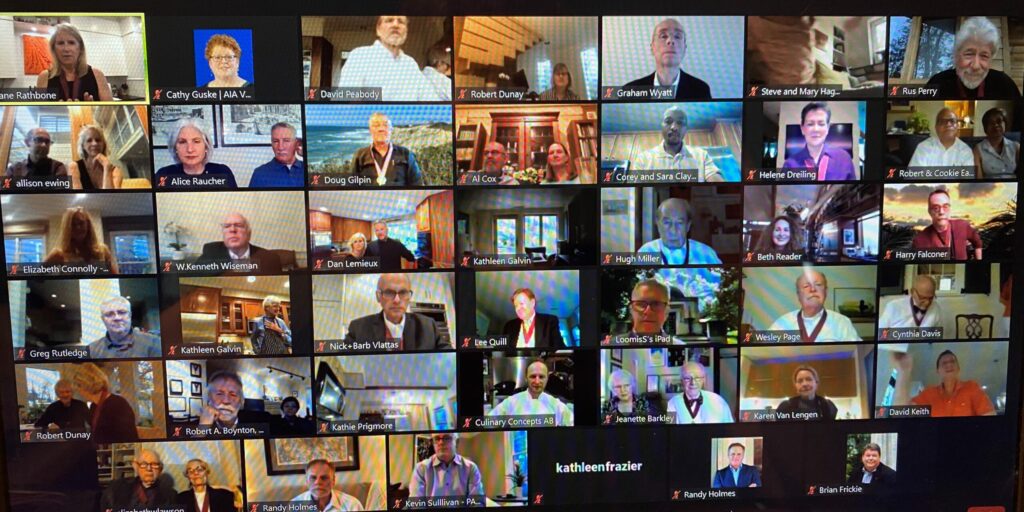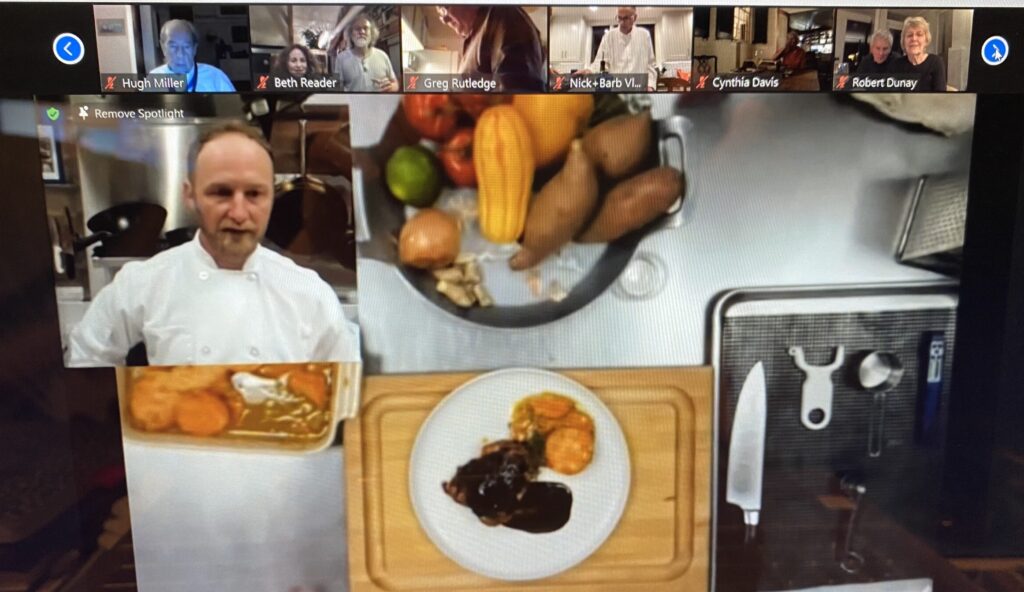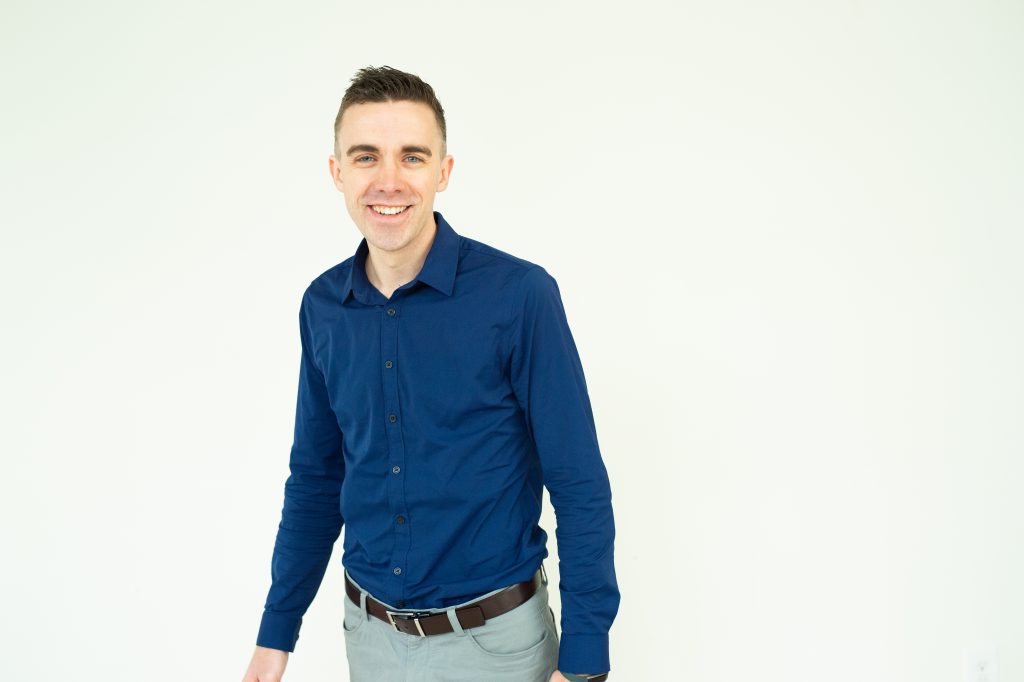What does architecture have to do with climate change? Quite a lot, actually, since the built environment is responsible for 40% of global carbon emissions. Don’t know where to start? Here’s a resource that outlines what you can do right now. In case you haven’t heard, there’s been a lot going on at AIA National around climate action in the last few years, including issuing a position statement on climate change, revising the AIA Professional Code of Ethics to include sustainability and equity, adopting a resolution for urgent climate action, making climate action one of six priorities in the AIA 2021-2025 strategic plan, and aligning the AIA Awards programs with the Framework for Design Excellence.
Our recently formed Virginia Committee on the Environment (COTE) Chapter is here to help get the word out on sustainability-focused initiatives that you can get involved in as well as on resources that you can use to make your work better. Keep checking back here each month for more tidbits.
Interested in getting involved? Email Rhea George for an invitation to our next meeting on May 18, 2021.
Meet Daniel J. Lemieux, FAIA
Director and Principal of Wiss, Janney, Elstner Associates, Inc. and Wiss, Janney, Elstner Limited, UK, Lemieux has led the advancement of building science in architecture throughout his over a 25-year career in professional practice and as a thought-leader in the development of international technical design and construction standards. Dan earned a Bachelor of Science, Architecture from the Georgia Institute of Technology (Georgia Tech).
Since joining WJE in 1996, Dan has successfully completed hundreds of projects in the area of building enclosure failure investigation, repair design, and architectural rehabilitation, including projects that have been recognized nationally for design and restoration excellence. As the firm’s Director of International Development, he is responsible for advancing WJE’s global architecture and building science practices. Prior to that, Dan served as Managing Principal of WJE’s Washington, D.C. office from 2005 to 2016.
Dan currently serves on multiple ASTM International committees including first vice chair of E06, Performance of Buildings and chair of E06.55, Performance of Building Enclosures. He is founding chair and a primary author of ASTM E2813, Standard Practice for Building Enclosure Commissioning (BECx) and worked closely with WJE colleagues and practicing and teaching professionals from across North America to support the development of ASTM E2813, ASTM E2947 Standard Guide for BECx and ASHRAE Standard 202 Commissioning Process for Buildings and Systems. He served as an author and technical editor for the National Institute of Building Sciences (NIBS) web-based Whole Building Design Guide and NIBS Guideline 3: Exterior Enclosure Technical Requirements for the Commissioning Process and is a core member and contributor to the AIA Knowledge Community on Building Performance.
Dan has developed, chaired and been invited to speak at multiple workshops and symposia on building science and the physics of building enclosure performance in North America, the UK, EU, UAE, and China, and co-chaired the Symposium on Building Physics and Conservation with Historic England and Historic Environment Scotland in London. In 2017, Dan helped establish the first overseas operating unit for WJE in London as a Royal Institute of British Architects (RIBA) Chartered Practice in the UK. He is a chartered member of RIBA, the Royal Institute of Chartered Surveyors (RICS), and a listed architect in the UK, Canada, and Australia.
Since the tragedy at Grenfell Tower, Dan was invited to review and offer technical input on proposed regulatory reforms in the UK in response to the fire and continues to work closely with WJE’s Fire and Life Safety practice on this topic through project work and as an active member of the Society of Fire Protection Engineers (SFPE) Europe.
Dan’s project work has included iconic buildings and cultural landmarks in the U.S. and worldwide, notably the post-seismic assessment, stabilization, and repair design of the Washington Monument and the Washington National Cathedral as well as failure investigation; repair design; design peer review; design-assist and supply-chain quality assurance services for clients and projects located in North and Central America the UK, EU, Middle East and Asia.
Where did you go to college?
Georgia Tech
What does it take to be an architect?
Creativity and perseverance…
Was there an architect that particularly inspired you?
In history, Brunelleschi, as you might expect, for embodying – and demonstrating through his own work – the creative potential that can be unleashed when nature, art, and science are brought together to inform and to deliver structurally efficient, unique, and truly inspiring architecture. For many of the same reasons today, I am most inspired by the work of Calatrava and, perhaps in a slightly more restrained way, the late Zaha Hadid…
What are you currently reading?
Re-reading Team of Rivals by Doris Kearns Goodwin and just starting A Promised Land by Barack Obama…
What’s the best meal you’ve ever had?
Dinner at Hisa Franko in the Soca River Valley near Kobarid, Slovenia. The history of this place, it’s pastoral setting in the shadow of nearby mountains, and the creativity of chef Ana Ros make this journey well worth the trip.
Why do you volunteer with AIA?
To give back, and to join with others to further develop and enhance the technical depth of our profession…
In a world facing what many now recognize as a climate emergency, we are for many of them the ‘first responders’ in this crisis – reacting to fires and leaning into increasingly violent weather to understand their origin so that we can deliver a safer and resilient built environment for those we continue to serve. To respond effectively to that challenge, it is imperative that we return to first principles in how we educate and train the next generation of architects in building science and the ‘art’ of delivering truly sustainable design.
The 2021 IAWA Kristine Fallon Prize
The IAWA Center announces the 2021 IAWA Kristine Fallon Prize of $5000, inviting professionals and scholars to extend research into an important arena – women in architecture who have made significant contributions to the field through their work practicing at large U.S. firms in the second half of the 20th century. With important contributions made by women at large firms fundamentally unknown, research that documents this information is urgent.
The International Archive of Women in Architecture (IAWA) was established in 1985 as a joint program of the College of Architecture and Urban Studies and the University Libraries at Virginia Tech. The purpose of the Archive is to document the history of women’s contributions to the built environment by collecting, preserving, and providing access to the records of women’s architectural organizations and the professional papers of women architects, landscape architects, designers, architectural historians, and critics, and urban planners.
The deadline for submissions is December 1, 2021.
Click here for submission information
Or contact Donna Dunay, Chair IAWA: ddunay@vt.edu
Selections from the IAWA Collections may be found at: IAWA_VT
We Walked Through Fire – But We Don’t Smell Like Smoke
AIA Virginia 2020 Year in Review
There is no question that we are starting to see light at the end of the COVID-19 tunnel. Those who are choosing to get vaccinated can now find access to several vaccine options. The Architectural Billings Index (ABI) in February showed that architecture firms are reporting an uptick in billings for the first time since the start of the pandemic over a year ago. Most believe that the worse of the pandemic crisis is over if we continue to exercise caution and follow the instructions of our public health experts.
As such, I am hopeful that each one of you has taken a moment to simply pause.
Pause for a second.
Reflect on the Year 2020 and what it meant to your personal life and your firm. Count your blessings.
We walked through the fire – but don’t smell like smoke!
Yes, we were inconvenienced. Greatly.
But most of us never had to wait in a four-mile-long line to get a free bag of groceries. You may have experienced a temporary pay cut or frozen salary, but the lights in your home stayed on. Somebody out here needs to hear this.
It is with a similar lens that I look back on the work of AIA Virginia in 2020 and cannot help but to smile from ear to ear. Our President at the time, Beth Reader, FAIA led with a steady tempo making sure our organization could fill the necessary gaps our members faced. For example, she played an instrumental role in our Operation: Reach, Retain, and Develop program with the national component of the American Institute of Architecture Students (AIAS). This offering was cobbled together and deployed faster than you could turn your head (Similar to how fast – in legislative terms – Congress passed the PPP bill).
This meant it was not perfect, but it was effective. It would not have been possible if it were not for the approximate 50 members who stepped up in a mentor capacity. I am forever grateful for you. You impacted lives and kept these recent graduates in the profession. Do not take my word for it – read the testimonials and talk to these young men and women yourself.
So, it is an honor and privilege to present to you the AIA Virginia 2020 Year in Review.
I hope you thumb through this document and at some point, say, Wow.
I hope you look at it and say, How can I be a part of this?
I hope you walk away being a proud member of this organization.
R. Corey Clayborne, FAIA, NOMA, MBA
Executive Vice President
Meeting of the Roundtables
Join us for an educational opportunity that brings together AIA members to discuss pertinent practice topics in a structured and facilitated format.
Connect with other firm leaders and build network of support for now and the future.
Earn 1.0 AIA LU
Zoom links will be sent once you register.
Large Firm Roundtable Meeting
Thursday, May 27
12-1 p.m.
Register>>
Mid-Sized Firm Roundtable Meeting
Thursday, May 27
12-1 p.m.
Register>>
Small Firm Roundtable Meeting
Thursday, May 27
4-5 p.m.
Register>>
Emerging Professionals Roundtable Meeting
Thursday, May 27
4-5 p.m.
Register>>
2021 Fellows Fete
On Saturday night, April 10th, the Region of The Virginias celebrated the 2020 and 2021 elevated fellows – 13 in total!!!
Our new Fellows Regional Representative, Jane Rathbone, FAIA, gathered nearly 60 fellows and their spouses and guests to raise a toast to the new fellows and then have some fun cooking a delicious dinner with Chef Rolf Strub from Culinary Concepts AB out of Charlottesville.


Thank you to our sponsors:


Associated Thoughts: On Making Mistakes
Mistakes happen. They happen all the time. But they especially happen when you are doing things for the first time. Like when you forget to put north arrows or door swings during that early pinup in design
school. Or you put chairs too close together, forgetting that people have to walk between the rows. An
unpinned family in Revit. An unexamined set of meeting minutes. A wall section with the air barrier on the
wrong side of the insulation. Not backing up. Keynoting the wrong spec section. Not asking for help soon
enough.
Learning how to be an architect can be a tightrope. Not enough knowledge and experience to move
quickly, but always pressed for time. Move too fast and you miss critical details, or you have to redo
something so it takes even longer. You want to be independent and showcase your growth and initiative,
but also need to ask for help to set things up correctly the first time before you barge ahead. Things that
take your boss 10 minutes might take you an hour. Things that seem simple–a lighting grid, a corner
detail, a presentation slide–get more involved when consultants and specifications and schedules and
contracts come up. And you miss things, sometimes without even realizing it.
To be a designer is to take risks, and to take risks means to invite mistakes and expose your professional (and sometimes personal) vulnerabilities. I certainly know what it’s like to realize you are in over your head, to be given a task and a deadline with no clue how to even begin, how it is to feel alone with no one around to help you because it’s a pandemic and the only living thing nearby is a houseplant. At that moment, it can be easy to hide and sit back, but I have learned that growing as a designer means exploring your mistakes, owning them, and asking for help early and often. Getting a building planned, drawn, and built requires more knowledge, time, and attention than any one person can have, let alone young designers tackling it for the first time. So even with the most dogged quality control processes in a firm, we still learn from the redlines, the busted dimensions, the misspellings, even as we hope to never see them again.
Your growth as a young designer is the inextricable balancing act of learning quickly and working humbly,
continually asking for help when you need it, and offering it when asked. In bravely surrendering the
veneer of the having-all-the-answers kind of architect, we open ourselves up to new ideas, better
processes, established rules, and gleaned expertise from the generations of architects before us, and the
wisdom of the communities that surround us. Some designers will tread longstanding paths, while others
will break new ground, each on their own pathway towards professional excellence and vulnerability. On
our own paths, we continue to learn from our own shortcomings and share that growth with others.
Mistakes happen, and they happen to the best and worst among us. We’ve all been there, and it’s never
fun, but it is inevitable in the iterative and collaborative world of real-life design.
In solidarity and action,
Michael Spory, Associate AIA
spory@vmdo.com
Newly Licensed
We understand the dedication and effort required to study for and pass the ARE. Congratulations to the following members for passing their exams and gaining licensure. This is great news that thrills all of us and we are so proud to call you architects!
Mr. John W. Elliott, AIA (Northern Virginia)
Ms. Erika L. Fegestad, AIA (Hampton Roads)
Mrs. Helen F. Jadlowski, AIA (Blue Ridge)
Mrs. Johanna Scogin, AIA (Richmond)
Mrs. Susy Mikhail, AIA (Northern Virginia)
Have you recently passed the ARE? Upgrade your membership to Architect using this AIA form. or send an email to your Member Services Director, Cathy Guske, cguske@aiava.org
New Members
We are always excited to welcome new members to Virginia. The following members recently joined the ranks of AIA Virginia.
New Architect Members
Mrs. Haley A. Arthur, AIA (Richmond)
Miss Allison C. Baker, AIA (Richmond)
Mr. Jeremiah Fordham, AIA (Northern Virginia)
Mr. Joseph N. O’Toole, AIA (Northern Virginia)
Mr. Jesse Quezada, AIA (Northern Virginia)
New Associate Members
Mr. Jacob Bushmire, Assoc. AIA (Richmond)
Ms. Mina Kang, Assoc. AIA (Northern Virginia)
Mr. Yi Li, Assoc. AIA (Northern Virginia)
Transferred In
Alison I. McBride, Assoc. AIA (Blue Ridge) from AIA California
Ms. Barbara F. Burns, AIA (Northern Virginia) from AIA DC
AIA Virginia Allied Members
Michael Maguire, Reg. Architectural Mgr. Mid-Atlantic, ROCKWOOL
View all of the AIA Virginia Allied members
At the Last Board Meeting
AIA Virginia | 2021 Board of Directors
February 26, 2021
Zoom Virtual Meeting
Motions Made and Approved:
The Board of Directors of AIA Virginia voted as follows:
- Acceptance of the Mid-Career Professionals Task Force Recommendations
- Acceptance of 2021 Signature Events Recommendations
- Appointments to the 2021 Honors Committee
- Appointments to the 2021 PAC Board of Trustees
- Approval of the 2020 Financial Audit
- Appointments to the 2021 Secretary’s Advisory Committee
- Appointments to the 2021 Nominating Committee
Motions Made and Approved in Closed Session:
The Board of Directors of AIA Virginia voted as follows:
- Approval of IRS Form 990 for Fiscal Year 2019-2020
- Adoption of Unanimous Consent of Directors Resolution for PPP Forgivable Loan
Written reports were provided for the following consent agenda items:
- General Assembly Update
- Lobby Month Update
- Membership Update
- Amber Book Program Update
- Virginia NOMA Update
- Emerging Leaders in Architecture Update
- AEC Virtual Symposium
- Economic Outlook from February 5, 2021
Members may request a copy of these written reports by emailing AIA Virginia Executive Vice President, Corey Clayborne, FAIA at cclayborne@aiava.org.
The next meeting of the 2021 AIA Virginia Board of Directors will occur virtually on April 23, 2021.



